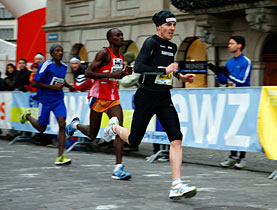Swiss develop food pyramid for athletes

Swiss nutrition experts have developed what is thought to be the first ever specialised food pyramid for athletes.
The pyramid, which was presented at a conference on applied sports nutrition at the Federal Institute of Technology in Zurich on Friday, also forms the core of a new Federal Sport Office book on the subject.
Classic food pyramids set out optimal nutrition guidelines for each food category with carbohydrates as well as fruit and vegetables at the bottom and sugary treats at the top. But until now there has not been one aimed at athletes’ specific needs, says the federal institute.
“Normal food guidelines are for the general public and include some recreational activity – two to three times fitness per week – but this cannot be designated as sports nutrition,” said Samuel Mettler, from the federal institute’s Department of Agriculture and Food, who helped draw up the Food Pyramid for Athletes.
“When you do more sports you need more energy and more carbohydrate and this is not implemented in normal pyramids,” he told swissinfo.
Defining an athlete as someone training five hours or more per week, the pyramid shows what a sportsman or woman needs to do to cover these additional nutritional requirements.
Athletes’ requirements
It shows, for example, that athletes do not necessarily need to increase their fruit and vegetable intake from the recommended five portions, but should up their wholegrain products and legumes by one serving per additional hour of exercise.
Also included are sports drinks and foods. “There are sports foods which are widely used and they ease nutrition in real life, so it doesn’t make sense to ignore this foodstuff,” explained Mettler.
The general aim is to provide practical guidelines on nutrition, as often people do not understand scientific recommendations, says the institute.
Since athletes use different amounts of energy when exercising, three different serving sizes were defined to suit their weight categories.
“The pyramid can’t consider all the specific aspects of every single sport for every single athlete, but as a guideline it works for a wide range of sports,” explained Mettler.
The pyramid also forms the basis of a new book on sports nutrition issued by the Federal Health Office, which along with the Swiss Forum for Sport Nutrition helped devise the pyramid.
Muscles and Muesli
The book Muscles and Muesli – Eating and Drinking in Sport also had its premiere at the conference.
It is full of practical advice aimed not only at athletes, but also their trainers and parents of sporty children.
According to Christof Mannhart, the federal office’s head of nutrition and book co-author, one important message is that people should not eat supplements – as often is the case in people doing a lot of sport – but food.
“A lot of people know much about sport nutrition but they know too many details and they lose sight of the basics,” he told swissinfo.
“So we make a step backwards to the roots, first you have to optimise the basics and then you can supplement your nutrition.”
Mettler pointed to a lack of qualified sports dieticians in Switzerland as another problem, as well as not having a specialised institute.
“Australia for example is absolutely leading, they are doing research and translating it into applied sports nutrition, bringing it to the athlete – we can only look up to them.”
swissinfo, Isobel Leybold-Johnson in Zurich
The new pyramid is based on the Food Pyramid designed by the Swiss Society for Nutrition. The original pyramid has been expanded to cover the energy and nutrient needs for daily exercise by athletes and active individuals.
This category is termed as healthy adults exercising most days of the week for at least one hour or more per day at moderate intensity, totalling at least 5 hours a week.
Moderate intensity covers continuous activities such as swimming and running, as well as “stop and go” of most intermittent and teams sports such as an ice hockey or football match.
It is suggested that athletes meet the guidelines consistently to ensure optimal regeneration and performance capability.

In compliance with the JTI standards
More: SWI swissinfo.ch certified by the Journalism Trust Initiative


You can find an overview of ongoing debates with our journalists here . Please join us!
If you want to start a conversation about a topic raised in this article or want to report factual errors, email us at english@swissinfo.ch.